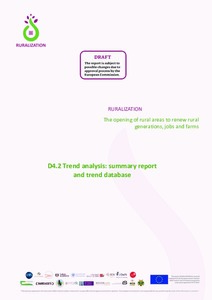RURALIZATION Project. The opening of rural areas to renew rural generations, jobs and farms. D4.2 Trend analysis: summary report and trend database
Janc Krzysztof; Volgmann Kati; Kuhmonen Tuomas; Ruuska Pertti; Raczyk Andrzej; Skrzypczyński Robert; Dołzbłasz Sylwia; Ahlmeyer Florian
https://urn.fi/URN:NBN:fi-fe2021102752616
Tiivistelmä
This report is a documentation for an extensive trend identification and assessment process
which was carried out by the RURAZATION team. A large diversity of trends was identified in
European research reports, scientific journals, futures literature as well as in national sources
to avoid the language bias. The approach of the trend analysis was exploratory, not
confirmatory or normative. The list of 1,560 trend observations is neither exhaustive nor
representative and fully balanced as there is no theory of the future that would guide us to
pick up the ‘correct’ trends. Each trend has both positive and negative impacts on specific
areas, sectors or actors and observing this diversity is important for understanding the
emergence and evolution of alternative futures. The general perspective on the trend analysis
has been rural regeneration: what kinds of force fields and developments could shape the
futures of rural Europe?
Each of the trend observations was assessed by the observer – supported by the source of the
trend – for its impacts on different types of rural areas (rural areas within functional urban
areas, rural areas in urban proximity and remote rural areas), gender, social capital, migration,
access to land, farm structures and farming prospects. Also the drivers of the trends were
identified. This process provided a good understanding of the diversity of the impacts of the
trends in various contexts.
In order to make the results more user-friendly, the findings were synthesised in 60 trend
cards. These cards feature the contents, drivers and impacts of 10 megatrends, 20 trends and
30 weak signals which could play in the rural regeneration. Obviously, there is no single silver
bullet trend that would bring about the desired outcomes for all regions. Rather, hopefully
each region, economic sector, policy field, business, decision-maker or citizen could find out
the way to benefit from (some of) the trends in specific contexts. This is the role in which the
trends cards are meant to serve and in the next steps of the RURALIZATION project this aspect
will be assessed in various interactive engagements.
Kokoelmat
- Rinnakkaistallenteet [19207]
